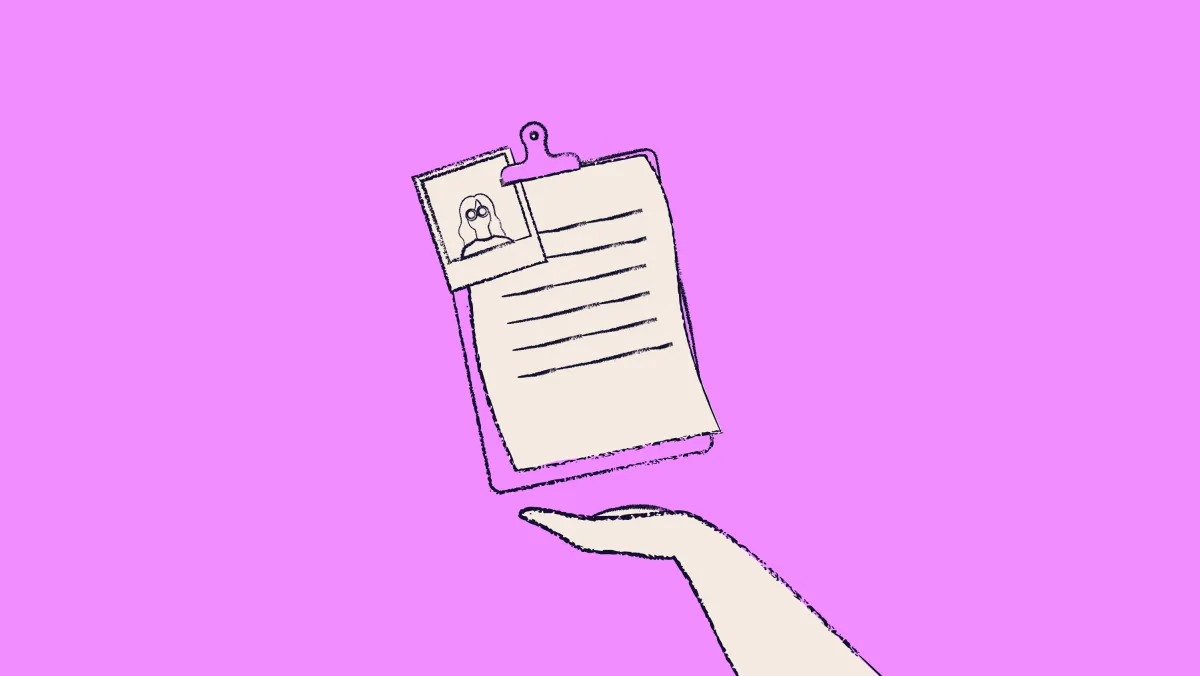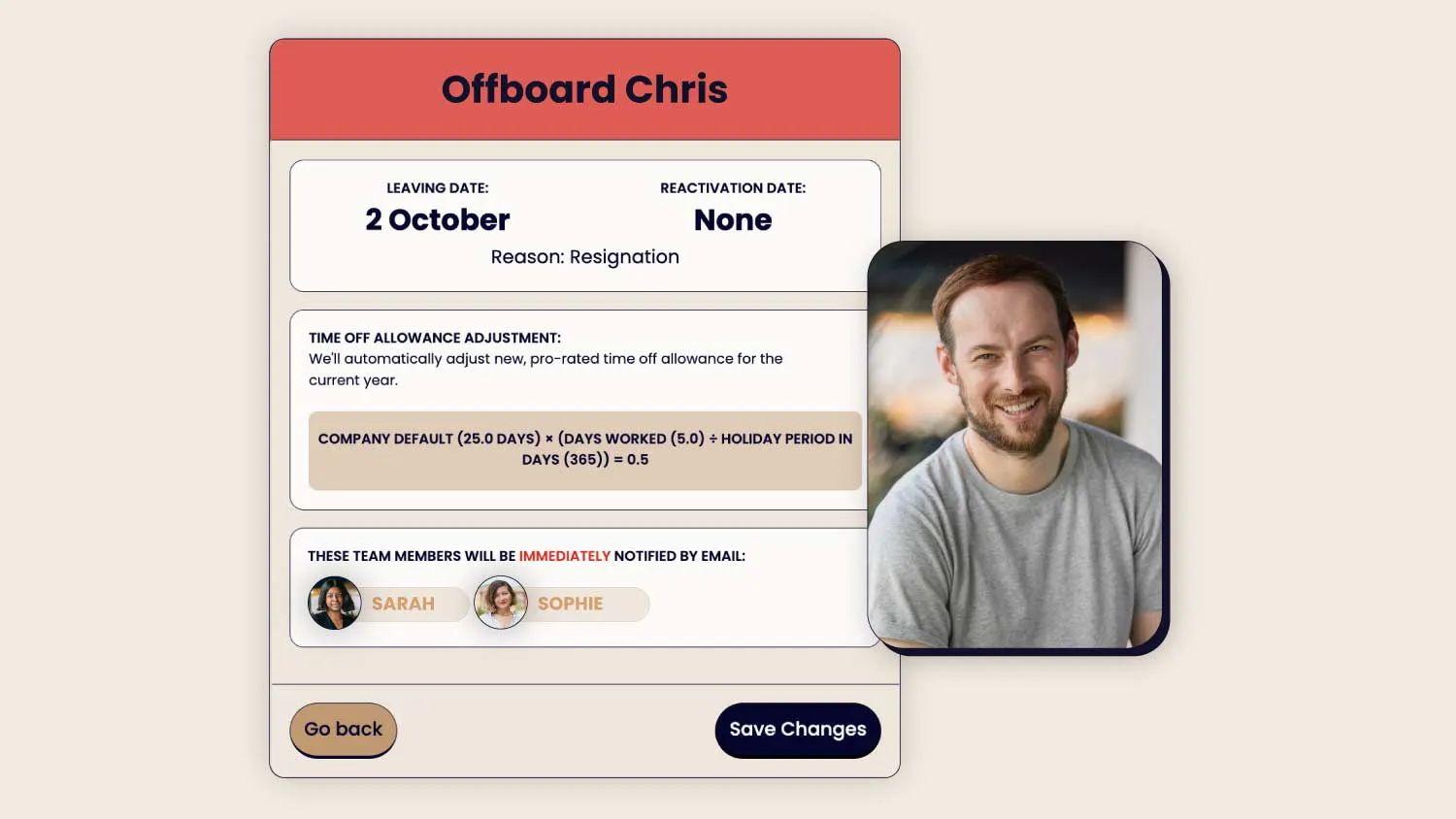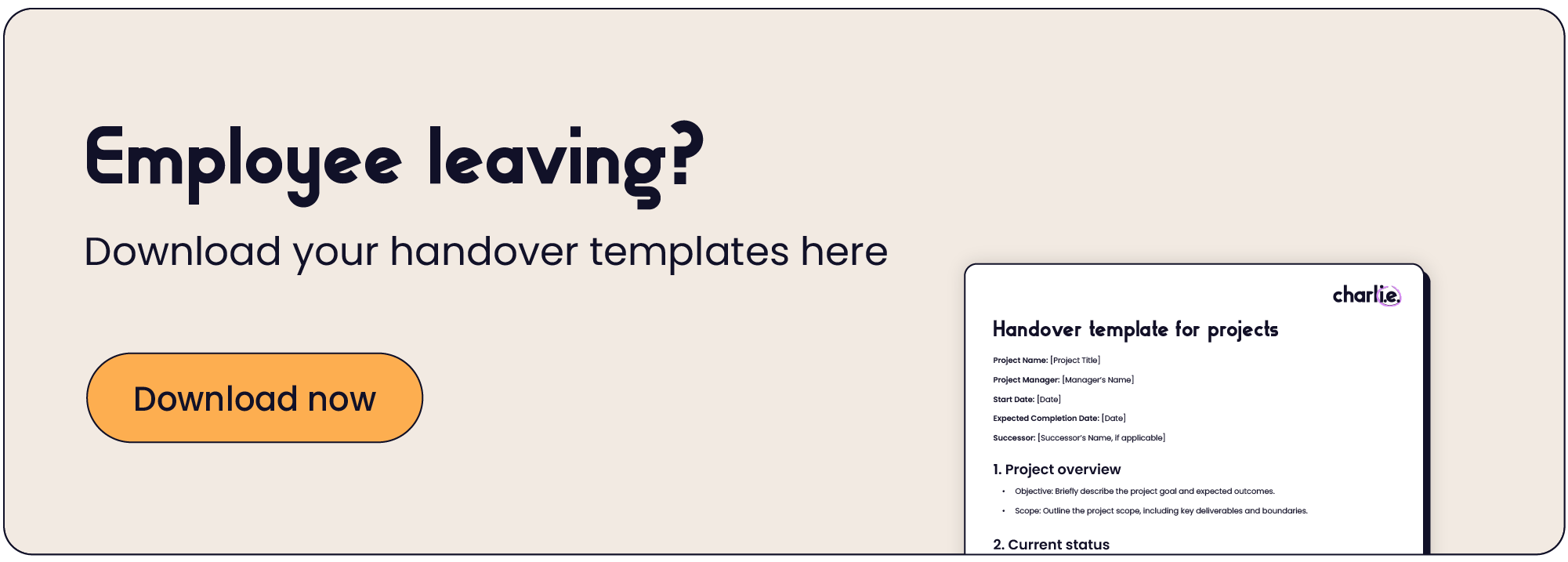Handover leaving template for smooth transitions – download for free

When your employee has to step down, move onto a new role or a new organisation, or go on extended leave, they leave behind a gap in knowledge and talent that you have to fill somehow. A Handover template is how you can make the best of a bad job.
With a handover template, you can set up whoever takes their place for success, minimise disruptions to your business, keep productivity flowing, and make the transfer as smooth as possible.
Making sure that the right information gets to the right people is easier said than done and it can't be just thought of during the exit interview. In this post, I’d like to get into the purpose of handovers and why you need them, how to make one, and offer you handover templates you can use yourself in a mix of situations.
What is a handover for employees?
A handover is the process of transferring job responsibilities, knowledge, and access to digital assets when an employee leaves a role, whether permanently or temporarily.
The UK has one of the highest employee turnover rates in Europe. About 16.8% of employees leave their jobs each year, and it’s only gotten worse since 2020.
That turnover comes with a steep price tag, as the cost for you to replace that employee could be between 30 to 200% of their salary.
A handover process facilitates the transfer of responsibility and knowledge from one pair of hands to the next. It makes sure the transition minimises disruptions to your business and keeps the wheels turning smoothly.
Your handover process should include these key components:
- Documentation: Any details on ongoing projects, deadlines, key contacts, and other important information needed for the incoming employee to do their job. It makes sure whoever gets passed the baton knows exactly what to do next.
- Knowledge Transfer: Training sessions, meeting details, and any wisdom and experience that can’t be put on paper should be passed onto the new employee.
- Digital Assets: Login information, access to your tech stack, shared drives, and the tools you use to coordinate projects are all things the new employee should be able to access.
- Action Plans: Outline any immediate or short-term objectives so the employee knows what to do from their first day and hit the ground running.
When do you need a handover document template?
There may be any number of reasons why your employee is leaving a role, but at one point or another, someone will have to take their place. The situations requiring handovers that I see most frequently are:
- Employee Resignation or Termination: When your team member leaves or another opportunity, a handover makes sure that their knowledge and experience don’t leave with them.
- Long-term Leave: An employee going on maternity leave, a sabbatical, or an extended medical leave will need someone to keep an eye on things for them until they come back.
- Internal Transfers and Promotions: An employee may switch departments or get promoted to a senior position. Well done them, but you still need someone to pick up where they left off as their responsibilities within your company change.
- Project Handoffs: In situations where the lead on a project changes, a handover will help get the new lead up to speed on the status of the current project phase.
Free handover templates to use for your team
To help your employee offboarding process, I’ve put together these handover templates you can use for the situations you might face. Feel free to take any or all of them and customise them to suit your business or download the PDF below.
Handover Template for Employee Resignation
Employee Name: [Employee’s Full Name]
Position: [Employee’s Job Title]
Last Working Day: [Date]
Successor: [If known, Successor’s Name]
1. Key responsibilities
- List major responsibilities, providing a brief description of each.
- Indicate any ongoing tasks with current status and next steps.
2. Important deadlines
- Detail upcoming deadlines within the next [timeframe].
- Include any relevant project milestones.
3. Critical documents and files
- Specify locations of critical documents and files (e.g., shared drives, specific folders).
- Highlight any confidential or sensitive information, adhering to data protection guidelines.
4. Key contacts
- List internal and external contacts relevant to the role, including stakeholders and clients.
- Provide contact details and a brief note on the nature of each relationship.
5. Access information
- Note any necessary login information for work-related accounts or platforms, ensuring this is done securely and in line with company policy on information security.
- Include instructions for transferring access rights where applicable.
6. Ongoing projects
- Summarize the status of ongoing projects, identifying any immediate actions required.
- Detail any handover meetings or briefings arranged.
7. Additional notes
- Include any other relevant information or personal insights that could assist the successor.
Signature: ___________________
Date: ___________________
Handover Template for Maternity Leave
Employee Name: [Employee’s Full Name]
Position: [Employee’s Job Title]
Leave Start Date: [Date]
Expected Return Date: [Date]
Temporary Cover: [If known, Name of the Person Covering the Role]
1. Preparation steps
- Notify HR and Team: Confirm leave dates with HR and communicate them to your team.
- Review Workload: Assess current projects and tasks to prioritize and delegate.
- Schedule Handover Meetings: Arrange meetings with your successor/temporary cover to discuss key responsibilities and ongoing projects.
2. Key responsibilities
- List primary duties and describe how they should be managed in your absence.
- Identify any tasks that can be postponed until your return.
3. Ongoing projects
- Provide an overview of all active projects, including status, deadlines, and next steps.
- Highlight any critical milestones occurring during the leave period.
4. Temporary responsibilities
- Detail any responsibilities being temporarily transferred to colleagues.
- Include instructions or guidelines for handling these tasks.
5. Important contacts
- List internal and external contacts, specifying any ongoing communications or pending actions.
- Include contact details and any relevant notes about each relationship.
6. Documentation and resources
- Direct to where essential documents and files are stored.
- Note any access rights or permissions that need to be granted to your temporary cover.
7. Additional notes
- Share any tips or insights that could help your temporary cover manage the role effectively.
- Mention any scheduled events or deadlines that require special attention.
Signature: ___________________
Date: ___________________
Handover template for projects
Project Name: [Project Title]
Project Manager: [Manager’s Name]
Start Date: [Date]
Expected Completion Date: [Date]
Successor: [Successor’s Name, if applicable]
1. Project overview
- Objective: Briefly describe the project goal and expected outcomes.
- Scope: Outline the project scope, including key deliverables and boundaries.
2. Current status
- Progress: Summarize current progress against planned milestones.
- Challenges: Highlight any challenges encountered and how they were addressed or need to be managed.
3. Key deliverables
- List upcoming deliverables with due dates and responsible parties.
- Include status (not started, in progress, completed) for each deliverable.
4. Upcoming milestones
- Detail critical milestones within the project timeline, including dates and specific objectives.
5. Resources
- Documentation: Direct project documentation, including plans, reports, and meeting minutes.
- Tools and Platforms: List tools and platforms used in the project, with access information if necessary.
6. Team and contacts
- Provide a list of project team members, their roles, and contact information.
- Include key stakeholders and external contacts relevant to the project.
7. Risks and mitigation strategies
- Outline identified risks and the strategies in place or recommended for mitigation.
8. Handover meetings
- Schedule or recommend meetings with critical team members or stakeholders to discuss the handover and address any questions.
9. Additional notes
- Share insights or advice that could assist in the successful continuation of the project.
Signature: ___________________
Date: ___________________
Handover for change of role
Employee Name: [Employee’s Full Name]
Current Position: [Employee’s Current Job Title]
New Position: [Employee’s New Job Title]
Transition Date: [Date]
Transition checklist
Document current responsibilities
- Task List: Create a comprehensive list of your current tasks, including daily, weekly, and monthly responsibilities.
- Project Status: For each project you’re involved in, document the current status, upcoming deadlines, and any pending actions.
Compile key documentation
- Operational Manuals: Gather any operational manuals or guidelines relevant to your current role.
- Project Documentation: Ensure all project-related documents are up-to-date and accessible.
Digital assets transfer
- Access Rights: List all digital tools and platforms you use, noting any access rights or permissions that need to be transferred.
- Files and Data: Ensure all relevant digital files are organized and stored in a shared location.
Schedule knowledge transfer sessions
- Meetings with Successor: Arrange meetings with your successor to go through your task list and any critical projects.
- Training Sessions: If specific skills or knowledge are required, schedule training sessions to facilitate skill transfer.
Update key contacts
- Internal Contacts: Provide a list of key internal contacts, outlining the nature of your interactions.
- External Stakeholders: Include contact information for any external stakeholders or clients, noting any ongoing communications or commitments.
Handover meetings
- Team Meeting: Inform your team about your role change and introduce your successor, if applicable.
- Stakeholder Meeting: Arrange a meeting with key stakeholders to communicate your transition and ensure continued project support.
Final review
- Handover Document: Review the handover document for completeness and accuracy.
- Feedback Session: Meet with your manager and successor to address any final questions or concerns.
Signature: ___________________
Date: ___________________
Workplace transitions are bumpy, but a handover leaving template makes them smoother. They help make sure that important details aren’t glossed over and the gap in skills and knowledge is filled as well as can be managed.
Use the templates I showed you, customise them to suit you, and implement them in your handover process. They help keep the cogs of your business going and position whoever is filling the employee’s spot for success.
You can also use CharlieHR for many of the admin tasks linked to handover templates:
- Store your handover templates in a secure place and have immediate access at any time to standardise your processes
- Don’t leave any detail behind when your team members leave by taking them through an offboarding flow and assigning checklists to everyone involved




